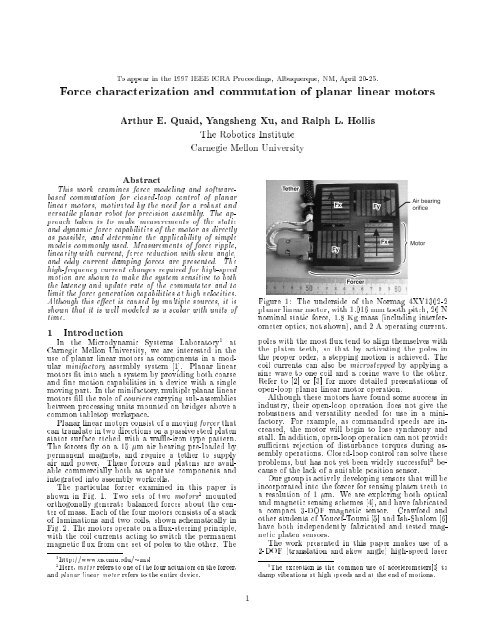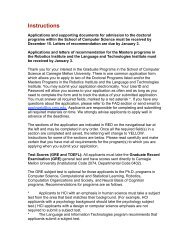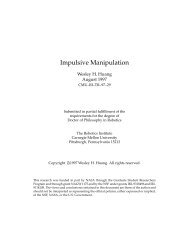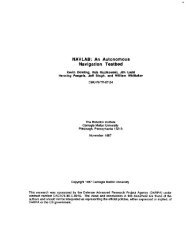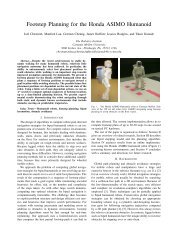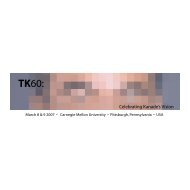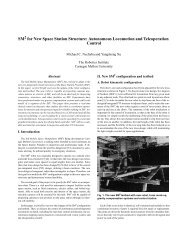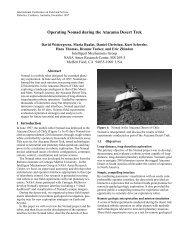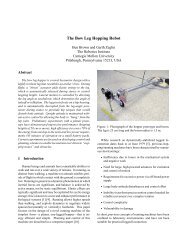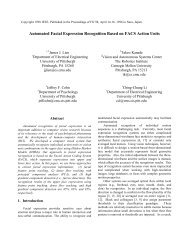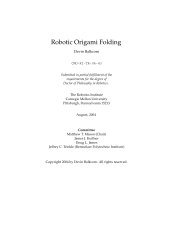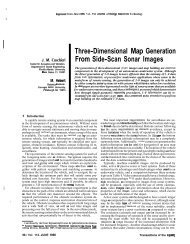Force characterization and commutation of planar linear motors
Force characterization and commutation of planar linear motors
Force characterization and commutation of planar linear motors
You also want an ePaper? Increase the reach of your titles
YUMPU automatically turns print PDFs into web optimized ePapers that Google loves.
To appear in the 1997 IEEE ICRA Proceedings, Albuquerque, NM, April 20-25.<br />
<strong>Force</strong> <strong>characterization</strong> <strong>and</strong> <strong>commutation</strong> <strong>of</strong> <strong>planar</strong> <strong>linear</strong> <strong>motors</strong><br />
Arthur E. Quaid, Yangsheng Xu, <strong>and</strong> Ralph L. Hollis<br />
Abstract<br />
This work examines force modeling <strong>and</strong> s<strong>of</strong>twarebased<br />
<strong>commutation</strong> for closed-loop control <strong>of</strong> <strong>planar</strong><br />
<strong>linear</strong> <strong>motors</strong>, motivated by the need forarobust <strong>and</strong><br />
versatile <strong>planar</strong> robot for precision assembly. The approach<br />
taken is to make measurements <strong>of</strong> the static<br />
<strong>and</strong> dynamic force capabilities <strong>of</strong> the motor as directly<br />
as possible, <strong>and</strong> determine the applicability <strong>of</strong> simple<br />
models commonly used. Measurements <strong>of</strong> force ripple,<br />
<strong>linear</strong>ity with current, force reduction with skew angle,<br />
<strong>and</strong> eddy current damping forces are presented. The<br />
high-frequency current changes required for high-speed<br />
motion are shown to make the system sensitive to both<br />
the latency <strong>and</strong> update rate <strong>of</strong> the commutator <strong>and</strong> to<br />
limit the force generation capabilities at high velocities.<br />
Although this e ect is caused by multiple sources, it is<br />
shown that it is well modeled asascalar with units <strong>of</strong><br />
time.<br />
1 Introduction<br />
In the Microdynamic Systems Laboratory 1 at<br />
Carnegie Mellon University, we are interested in the<br />
use <strong>of</strong> <strong>planar</strong> <strong>linear</strong> <strong>motors</strong> as components in a modular<br />
minifactory assembly system [1]. Planar <strong>linear</strong><br />
<strong>motors</strong> t into such a system by providing both coarse<br />
<strong>and</strong> ne motion capabilities in a device with a single<br />
moving part. In the minifactory,multiple <strong>planar</strong> <strong>linear</strong><br />
<strong>motors</strong> ll the role <strong>of</strong> couriers carrying sub-assemblies<br />
between processing units mounted on bridges above a<br />
common tabletop workspace.<br />
Planar <strong>linear</strong> <strong>motors</strong> consist <strong>of</strong> a moving forcer that<br />
can translate in two directions on a passive steel platen<br />
stator surface etched with a wa e-iron type pattern.<br />
The forcers y on a 15 m air bearing pre-loaded by<br />
permanent magnets, <strong>and</strong> require a tether to supply<br />
air <strong>and</strong> power. These forcers <strong>and</strong> platens are available<br />
commercially both as separate components <strong>and</strong><br />
integrated into assembly workcells.<br />
The particular forcer examined in this paper is<br />
shown in Fig. 1. Two sets <strong>of</strong> two <strong>motors</strong> 2 mounted<br />
orthogonally generate balanced forces about the center<br />
<strong>of</strong> mass. Each <strong>of</strong> the four <strong>motors</strong> consists <strong>of</strong> a stack<br />
<strong>of</strong> laminations <strong>and</strong> two coils, shown schematically in<br />
Fig. 2. The <strong>motors</strong> operate on a ux-steering principle,<br />
with the coil currents acting to switch the permanent<br />
magnetic ux from one set <strong>of</strong> poles to the other. The<br />
1 http://www.cs.cmu.edu/ msl<br />
2 Here, motor refers to one <strong>of</strong> the four actuators on the forcer,<br />
<strong>and</strong> <strong>planar</strong> <strong>linear</strong> motor refers to the entire device.<br />
The Robotics Institute<br />
Carnegie Mellon University<br />
1<br />
Figure 1: The underside <strong>of</strong> the Normag 4XY1302-2<br />
<strong>planar</strong> <strong>linear</strong> motor, with 1.016 mm tooth pitch, 26 N<br />
nominal static force, 1.8 Kg mass (including interferometer<br />
optics, not shown), <strong>and</strong> 2 A operating current.<br />
poles with the most ux tend to align themselves with<br />
the platen teeth, so that by activating the poles in<br />
the proper order, a stepping motion is achieved. The<br />
coil currents can also be microstepped by applying a<br />
sine wave to one coil <strong>and</strong> a cosine wave to the other.<br />
Refer to [2] or [3] for more detailed presentations <strong>of</strong><br />
open-loop <strong>planar</strong> <strong>linear</strong> motor operation.<br />
Although these <strong>motors</strong> have found some success in<br />
industry, their open-loop operation does not give the<br />
robustness <strong>and</strong> versatility needed for use in a minifactory.<br />
For example, as comm<strong>and</strong>ed speeds are increased,<br />
the motor will begin to lose synchrony <strong>and</strong><br />
stall. In addition, open-loop operation can not provide<br />
su cient rejection <strong>of</strong> disturbance torques during assembly<br />
operations. Closed-loop control can solve these<br />
problems, but has not yet been widely successful 3 because<br />
<strong>of</strong> the lack <strong>of</strong> a suitable position sensor.<br />
Our group is actively developing sensors that will be<br />
incorporated into the forcer for sensing platen teeth to<br />
a resolution <strong>of</strong> 1 m. We are exploring both optical<br />
<strong>and</strong> magnetic sensing schemes [4], <strong>and</strong> have fabricated<br />
a compact 3-DOF magnetic sensor. Crawford <strong>and</strong><br />
other students <strong>of</strong> Youcef-Toumi [5] <strong>and</strong> Ish-Shalom [6]<br />
have both independently fabricated <strong>and</strong> tested magnetic<br />
platen sensors.<br />
The work presented in this paper makes use <strong>of</strong> a<br />
2-DOF (translation <strong>and</strong> skew angle) high-speed laser<br />
3 The exception is the common use <strong>of</strong> accelerometers[3] to<br />
damp vibrations at high speeds <strong>and</strong> at the end <strong>of</strong> motions.
Figure 2: Basic <strong>linear</strong> motor operation: Current in the<br />
motor coils generates magnetic ux (dark ux path)<br />
that sums with the permanent magnet ux (light ux<br />
path) to produce forces.<br />
interferometer as a position sensor. Whereas this sensor<br />
has better b<strong>and</strong>width <strong>and</strong> precision than a platen<br />
tooth sensor, the work presented in this paper is independent<br />
<strong>of</strong> the particular sensor used, provided it<br />
meets the minimum b<strong>and</strong>width <strong>and</strong> resolution requirements.<br />
This work is also independent <strong>of</strong> the higher<br />
level closed-loop control method used for controlling<br />
the forcer.<br />
2 Motor Commutation<br />
In the context <strong>of</strong> <strong>planar</strong> <strong>linear</strong> <strong>motors</strong>, a commutator<br />
is simply a mechanism that selects motor currents<br />
to achieve a desired force. The usefulness <strong>of</strong> a commutator<br />
is in providing higher level controllers with<br />
an ideal force source (within actuator limits), as opposed<br />
to a system where a current must be speci ed for<br />
each coil. Commutators separated from higher level<br />
controllers are especially important for <strong>planar</strong> <strong>linear</strong><br />
<strong>motors</strong> because currents must be comm<strong>and</strong>ed at KHz<br />
rates. For example, to operate the <strong>planar</strong> <strong>linear</strong> motor<br />
<strong>of</strong> Fig. 1 at 1 m/s, a sine wave <strong>of</strong> nearly 1 KHz must<br />
be applied to the motor coils, calling for updates <strong>of</strong> at<br />
least 2 KHz.<br />
Typically, the forcers are assumed to generate forces<br />
according to the relation:<br />
F gen = ki a sin( )+ki b cos( ); (1)<br />
where F gen is the total force generated by the x-axis<br />
motor pair, k is a constant with units <strong>of</strong> force over<br />
current, i is the current in coil , <strong>and</strong> is the phase<br />
<strong>of</strong> the motor. The phase is de ned as the position <strong>of</strong><br />
the motor relative to the nearest tooth pitch, expressed<br />
as an angle:<br />
= 2 x= ; (2)<br />
where is the tooth pitch. This force expression assumes<br />
no manufacturing errors, no magnetic saturation,<br />
uniform teeth, perfect ampli ers, in nite update<br />
rates, <strong>and</strong> no rotation <strong>of</strong> the forcer. An identical equation<br />
applies to the y-axis motor pair.<br />
It is convenient to re-parameterize the input currents<br />
according to:<br />
i a = i cos( ) <strong>and</strong> i b = ,i sin( ); (3)<br />
2<br />
Figure 3: Test setup for static force measurements.<br />
where i <strong>and</strong> are the new parameters. Combining (1)<br />
<strong>and</strong> (3) <strong>and</strong> simplifying yields:<br />
F gen = ki sin( , ): (4)<br />
For open-loop control, force is not usually controlled,<br />
but rather the equilibrium position <strong>of</strong> the motor.<br />
Typically, i is kept constant at the maximum<br />
value, <strong>and</strong> a value <strong>of</strong> = des is used to shift the<br />
equilibrium position <strong>of</strong> the motor to des.<br />
For closed-loop control, a xed amplitude commutator<br />
can be designed that also keeps i at its maximum<br />
value. However, is now varied to generate forces<br />
by setting it to = , arcsin(F des=ki). This <strong>commutation</strong><br />
scheme requires large currents to be in the<br />
motor coils at all times, resulting in unwanted thermal<br />
e ects, but also a potentially useful passive sti ness.<br />
Alternatively, the other input parameter, , can<br />
be xed relative to the motor position so that the<br />
motor is always operating at the peak <strong>of</strong> the sti ness<br />
curve by setting = , =2. In this approach, force<br />
is controlled by varying the amplitude i according to<br />
i = F des=k. This xed phase commutator will have<br />
reduced thermal e ects, but no passive sti ness.<br />
In the following sections, static <strong>and</strong> dynamics tests<br />
are performed to determine whether the assumptions<br />
made for (1) are valid.<br />
3 Static <strong>Force</strong> Characterization<br />
Static force measurements are performed using a<br />
locked rotor test commonly used in motor modeling.<br />
In this test, a constant set <strong>of</strong> currents is applied to the<br />
motor coils. A load is applied to the motor through<br />
a force gauge, <strong>and</strong> the force is recorded as the motor<br />
de ects from its equilibrium position. The test setup<br />
is shown in Fig. 3.<br />
The locked rotor test is slightly more complicated<br />
for <strong>planar</strong> <strong>linear</strong> <strong>motors</strong> because their air bearings allow<br />
for 3 DOFs. An external constraint or rotation<br />
servo is required to keep the forcer from rotating. As<br />
an external constraint would be di cult to align, the y<br />
<strong>motors</strong> <strong>of</strong> the forcer are used to regulate the skew angle<br />
to zero. A PID angle controller with a xed-amplitude<br />
commutator is used for skew angle regulation <strong>and</strong> passive<br />
sti ness in the (unsensed) y direction.
force [N]<br />
40<br />
30<br />
20<br />
10<br />
0<br />
−10<br />
−20<br />
−30<br />
−40<br />
0 0.2 0.4 0.6 0.8 1 1.2 1.4 1.6 1.8 2<br />
position [mm]<br />
Figure 4: <strong>Force</strong> versus position ( ), measured data ( )<br />
di er from a sine function (solid line) by a small error<br />
(dashed line). Here, =0 <strong>and</strong> i = 2A.<br />
3.1 Experimental setup<br />
The experimental setup, shown in Fig. 3, consists<br />
<strong>of</strong> a Normag forcer on a Normag platen connected<br />
through a double universal joint linkage to an Entran<br />
load cell. The load cell is mounted on a 3-axis micrometer<br />
stage, with the x translation controlled by<br />
a Newport automated micrometer. The coupling between<br />
the forcer <strong>and</strong> load cell is designed to transmit<br />
only axial forces, <strong>and</strong> to attach to the forcer as low as<br />
possible, to minimize torques that may tend to de ect<br />
the air bearing. As there is signi cant compliance in<br />
this coupling, a Zygo two-axis high-speed interferometer<br />
is used to monitor the true position <strong>and</strong> skew angle<br />
<strong>of</strong> the forcer.<br />
For these tests, the currents in the x <strong>motors</strong> <strong>of</strong> the<br />
forcer are set to xed values using (3). After setting<br />
these currents, there is a delay <strong>of</strong>10minutes to minimize<br />
thermal expansions during data collection. Next,<br />
the micrometer is comm<strong>and</strong>ed to move in short increments<br />
over a range <strong>of</strong> two pitch units. After the<br />
micrometer settles to each comm<strong>and</strong>ed position, the<br />
load cell <strong>and</strong> interferometer are read <strong>and</strong> the values<br />
stored. The force generated by the forcer as a function<br />
<strong>of</strong> position is shown in the sti ness curve <strong>of</strong> Fig.<br />
4. This test is repeated with di erent values <strong>of</strong> parameters<br />
<strong>and</strong> i in (3). The data collection procedure is<br />
fully automated, allowing more data to be collected<br />
than would otherwise be feasible.<br />
3.2 Experimental results<br />
A total <strong>of</strong> 127 tests were completed to generate sti -<br />
ness curves for from 0 to 180 , <strong>and</strong> for i from -2.0 A<br />
to 2.0 A. For each run, the micrometer was positioned<br />
every 25 m along a 2032 m (2 pitch) distance. The<br />
total data collection time was about 32 hours, taken<br />
over several days.<br />
Fig. 4 shows a typical sti ness curve. Note that<br />
the sine function matches the data points 4 to within<br />
1.5 N. Also note that, neglecting higher harmonics, it is<br />
only the amplitude <strong>of</strong> the sine function which is useful,<br />
because the phase <strong>and</strong> period <strong>of</strong> the sine function are<br />
determined by the tooth pitch <strong>and</strong> the phase .Thus,<br />
only the peaks <strong>of</strong> the sti ness curves can be plotted for<br />
multiple runs on one diagram, as in Fig. 5. This gure<br />
4 The points are not evenly spaced due to compliance in the<br />
force linkage.<br />
3<br />
force amplitude [N]<br />
40<br />
30<br />
20<br />
10<br />
0<br />
−10<br />
−20<br />
−30<br />
0.00 A<br />
−40<br />
0 22.5 45 67.5 90 112.5 135 157.5 180<br />
<strong>commutation</strong> phase (degrees)<br />
2.00 A<br />
1.50 A<br />
1.25 A<br />
1.00 A<br />
0.75 A<br />
0.50 A<br />
0.25 A<br />
−0.25 A<br />
−0.50 A<br />
−0.75 A<br />
−1.00 A<br />
−1.25 A<br />
−1.50 A<br />
−2.00 A<br />
Figure 5: <strong>Force</strong> ripple, showing the peak force capability<br />
<strong>of</strong> the forcer as a function <strong>of</strong> input parameters<br />
<strong>and</strong> i.<br />
Peak force [N]<br />
30<br />
20<br />
10<br />
0<br />
−10<br />
−20<br />
−30<br />
−2 −1.5 −1 −0.5 0 0.5 1 1.5 2<br />
Current in coil A [amps]<br />
Figure 6: <strong>Force</strong> <strong>linear</strong>ity, showing peak force as a function<br />
<strong>of</strong> i, with =0. Measured values (+), <strong>and</strong> Eq. (5)<br />
t to these data (solid line).<br />
shows the variation <strong>of</strong> the peak force <strong>of</strong> the forcer as<br />
the parameters i <strong>and</strong> vary.<br />
This plot shows signi cant force ripple when the<br />
motor is commutated with (3), exceeding 20% in<br />
places. If smoother force generation is desired, these<br />
data can be used to correct the motor forces. One<br />
approach is to generate a lookup table that gives an<br />
appropriate set <strong>of</strong> currents as a function <strong>of</strong> the phase<br />
angle <strong>and</strong> desired force, as in [7]. However, this technique<br />
requires a complete set <strong>of</strong> force data to generate<br />
the lookup table for each forcer. While three days <strong>of</strong><br />
data collection to get these data once is reasonable, it<br />
seems excessive to do this for each forcer needed in a<br />
minifactory.<br />
Fortunately, wemay be able to use a simpler technique.<br />
Plotting a vertical cross section <strong>of</strong> the data for<br />
=0 produces Fig. 6. This curve should be close to<br />
<strong>linear</strong> if (1) is valid. However, there is signi cant deviation<br />
from <strong>linear</strong>ity due to magnetic saturation. This<br />
non<strong>linear</strong> function is well modeled by a simple function<br />
such as 5 :<br />
f c = a0i c , a1 ji cj i c; (5)<br />
where i c is the current applied to the motor coil, f c<br />
is the peak force generated by the coil, <strong>and</strong> a0 <strong>and</strong> a1<br />
5 Chai <strong>and</strong> Leenhouts[8] have used similar empirical functions<br />
to model the saturation in rotary stepper <strong>motors</strong>.
Peak force [N]<br />
40<br />
35<br />
30<br />
25<br />
20<br />
−1 −0.8 −0.6 −0.4 −0.2 0 0.2 0.4 0.6 0.8 1<br />
Skew angle [degrees]<br />
Figure 7: Peak force as a function <strong>of</strong> forcer skew angle,<br />
with i=2 A <strong>and</strong> 1;2 =0 (solid line) or 1;2 =45<br />
(dashed line).<br />
are positive parameters that must be determined for<br />
each motor coil. The curve connecting the data points<br />
in Fig. 6 is generated by computing the a0 <strong>and</strong> a1<br />
parameters based only on the slope <strong>of</strong> the data at zero<br />
current <strong>and</strong> the magnitudes at maximum currents. In<br />
contrast to a 3D lookup table, the data needed to t<br />
this curve can be taken in a manner <strong>of</strong> minutes using a<br />
h<strong>and</strong>-held force gauge for a pull-out test to determine<br />
the peak forces for only four values <strong>of</strong> i. Early results<br />
indicate that the magnetic saturation e ect accounts<br />
for slightly more than half <strong>of</strong> the force ripple. The<br />
remaining ripple is probably due to higher order terms<br />
in the sti ness curves.<br />
<strong>Force</strong> generated by the forcers is also dependent on<br />
the skew angle. As the forcer rotates slightly, the long<br />
motor teeth only partially overlap the platen teeth,<br />
causing the peak force to decrease. At large rotations,<br />
the forcers can not operate, but they can be used as<br />
a ne-motion device with a motion range <strong>of</strong> a few degrees.<br />
To allow control <strong>of</strong> the motor skew angle, it must<br />
be included in Eq. (1). The misalignment <strong>of</strong> teeth will<br />
cause a decrease in k with increasing angle magnitude,<br />
<strong>and</strong> the phases <strong>of</strong> the two <strong>motors</strong> mounted on opposite<br />
sides <strong>of</strong> the forcer will shift in opposite directions<br />
as the angle changes. Thus, Eq. (1) <strong>and</strong> Eq. (2) are<br />
replaced by:<br />
F gen = k( )i a1 sin( 1)+k( )i b1 cos( 1)<br />
+k( )i a2 sin( 2)+k( )i b2 cos( 2); (6)<br />
1 = x + ; 2 = x , ; (7)<br />
where x is given by (2). The e ect <strong>of</strong> on the phase<br />
position <strong>of</strong> each motor is re ected in the term =<br />
l 2 = , where, is the forcer skew angle, <strong>and</strong> l is<br />
half the distance between each pair <strong>of</strong> <strong>motors</strong>. Note<br />
that four current values per axis are needed to control<br />
the forcer rotation, so that (3) is replaced by:<br />
i a1 = i cos( 1 + ); i b1 = ,i sin( 1 + );<br />
i a2 = i cos( 2 , ); i b2 = ,i sin( 2 , ):(8)<br />
These equations will feed-forward the appropriate<br />
phase to each motor based on the rotation angle. However,<br />
the function k( ) is still unknown. To examine<br />
this function, the locked rotor test is repeated, using<br />
the y <strong>motors</strong> to servo the forcer skew angle to nonzero<br />
values. The data in Fig. 7 show a force dropo<br />
with increasing angle magnitude, as expected. Each<br />
plot also shows an artifact from the uncompensated<br />
force ripple, because as changes, the arguments <strong>of</strong><br />
the transcendentals in (8) will change. Thus, the ripple<br />
shown as varies in Fig. 5 also appears here.<br />
4<br />
Figure 8: System latencies <strong>and</strong> control rates cause the<br />
motor's output force to drop at high velocities.<br />
4 Dynamic measurements<br />
The importance <strong>of</strong> dynamic e ects was evident in<br />
initial closed-loop control experiments using the xed<br />
phase commutator described in Sec. 2. While our<br />
open-loop controllers were able to drive <strong>motors</strong> to velocities<br />
over 1 m/s, <strong>motors</strong> under closed-loop control<br />
could not reach even half that speed. As discussed below,<br />
the reason for this limitation is delays in the commutator,<br />
which can be corrected by adding a phase<br />
advance term to the forcer position.<br />
Another signi cant dynamic e ect is the eddy current<br />
damping force caused by the large time-varying<br />
magnetic elds generated as the motor passes over the<br />
unlaminated steel platen surface. As these forces act in<br />
opposition to the forcer velocity, they are <strong>of</strong>ten treated<br />
as a mechanical damping e ect [9]. As shown below,<br />
these forces can be measured by examining the acceleration<br />
responses resulting from bidirectional step force<br />
comm<strong>and</strong>s.<br />
4.1 Phase advance<br />
The initial closed-loop controller does not perform<br />
as well as the open-loop controller because the feedback<br />
loop contains delays, making the motor position<br />
sensed at the beginning <strong>of</strong> the closed-loop cycle invalid<br />
by the time the output is produced. Fig. 8 shows this<br />
e ect in more detail. The sti ness curve shown assumes<br />
the motor is at the location read by the sensor.<br />
The goal is to set the motor currents so that the motor<br />
is operating at the peak <strong>of</strong> the sti ness curve, shown<br />
as a star. However, while the sensor signal is being<br />
processed <strong>and</strong> new outputs take e ect, the motor will<br />
have moved, causing the output to miss the peak <strong>of</strong><br />
the sti ness curve by an amount v t l, the velocity <strong>of</strong><br />
the motor times the latency. In addition, since the<br />
updates occur at discrete times, the motor force over<br />
the next output cycle will span a range <strong>of</strong> the sti ness<br />
curve <strong>of</strong> length v=r, where v is the motor velocity <strong>and</strong><br />
r is the output update rate in Hz. So instead <strong>of</strong> getting<br />
the comm<strong>and</strong>ed force (the star), we get a reduced<br />
force that changes during the output interval (the bold<br />
arrow). By using a phase advance term <strong>of</strong> vt l + v<br />
2r we<br />
can shift the bold arrow so that it is centered about<br />
the peak <strong>of</strong> the sti ness curve 6 . The approach isto<br />
determine the latency time <strong>and</strong> <strong>commutation</strong> rate <strong>of</strong><br />
6 Note that the average force will always be lower than the<br />
peak for nite <strong>commutation</strong> rates, <strong>and</strong> that with xed <strong>commutation</strong><br />
rates, this e ect will cause the available force to decrease<br />
with velocity.
Average Acceleration [m/s^2]<br />
18<br />
16<br />
14<br />
12<br />
10<br />
300 350 400 450 500 550 600 650 700<br />
Phase advance time [usecs]<br />
Figure 9: Average acceleration as a function <strong>of</strong> the<br />
phase advance time. The computed value is indicated<br />
by the vertical dashed line.<br />
the commutator <strong>and</strong> compute a delay time (in units<br />
<strong>of</strong> seconds). This value is multiplied by the latest velocity<br />
to get a phase advance position o set, which is<br />
added to the latest position. The sum is the expected<br />
motor position when the output takes e ect.<br />
Commutator latencies include input <strong>and</strong> output delays<br />
<strong>and</strong> computation times. For our system, the input<br />
delay is negligible. The <strong>commutation</strong> code running on<br />
a Motorola 68040 takes 200 s to compute output currents<br />
based on the input position.<br />
The ampli ers introduce an output delay which is<br />
slightly more complicated to measure. To do so, a<br />
spectrum analyzer is used to measure the transfer function<br />
<strong>of</strong> the ampli er driving one motor <strong>of</strong> a stationary<br />
forcer oating on the platen. Note that the ampli er<br />
dynamics can be reasonably modeled by a constant<br />
delay time as long as the lowest frequency poles <strong>and</strong><br />
zeros are above the driving frequencies <strong>of</strong> interest. If<br />
this is not the case, the delay time will have tovary<br />
with the comm<strong>and</strong>ed velocity. For our ampli er, the<br />
lowest pole appears to be at 1400 Hz, yielding a constant<br />
delay time <strong>of</strong> 114 s.<br />
The last delay is from the <strong>commutation</strong> update rate,<br />
3500 Hz for these tests, giving a total delay time <strong>of</strong><br />
1<br />
2<br />
1<br />
+ 114 + 200 = 457 s:<br />
3500<br />
This value is the delay time that is multiplied by the<br />
motor velocity to compute the amount <strong>of</strong> phase advance.<br />
4.2 Experimental veri cation<br />
Tovalidate the estimated phase advance delay time,<br />
full scale force comm<strong>and</strong>s are sent to a xed phase<br />
commutator controlling the x <strong>motors</strong> <strong>of</strong> the forcer for<br />
a range <strong>of</strong> values for the phase advance delay time.<br />
As with the static force measurements, a PID controller<br />
with a xed amplitude commutator controlling<br />
the y <strong>motors</strong> is used to prevent both skew angles <strong>and</strong><br />
y translations. <strong>Force</strong> comm<strong>and</strong>s are generated such<br />
that the motor will accelerate forward <strong>and</strong> backwards<br />
at maximum acceleration between velocities <strong>of</strong> -1 m/s<br />
<strong>and</strong> 1 m/s several times 7 . The complete sequence typically<br />
takes less than 0.5 s, with motions <strong>of</strong> under 50<br />
mm.<br />
The interferometer position data for the two long<br />
constant acceleration segments are di erenced to get<br />
velocity. Over repeated runs with varying phase advance<br />
delay times, the fastest response indicates the<br />
best value for the delay time. To quantify the fastest<br />
response, a velocity <strong>of</strong> 1.6 m/s is divided by the time<br />
7 While the forcer can move as fast as 2 m/s, the interferometer<br />
has a limit <strong>of</strong> 1 m/s.<br />
5<br />
Position [m]<br />
Velocity [m/s]<br />
0.03<br />
0.025<br />
0.02<br />
0.015<br />
0.01<br />
0.005<br />
0<br />
0 0.01 0.02 0.03<br />
Time [seconds]<br />
0.04 0.05 0.06<br />
1<br />
0.8<br />
0.6<br />
0.4<br />
0.2<br />
0<br />
0 0.01 0.02 0.03<br />
Time [seconds]<br />
0.04 0.05 0.06<br />
Figure 10: Trajectory (solid line) tracking with<br />
(dashed line) <strong>and</strong> without (dotted line) phase advance.<br />
it takes for the forcer to change from +0.8 m/s to -0.8<br />
m/s, to compute an average acceleration.<br />
Fig. 9 shows this average acceleration as a function<br />
<strong>of</strong> the phase advance time. Note that the peak force<br />
matches the phase advance time computed in the previous<br />
section to within 50 s.<br />
To demonstrate the improvement from the phase<br />
advance term, Fig. 10 shows the position <strong>and</strong> velocity<br />
trajectories for a peak acceleration comm<strong>and</strong> starting<br />
from a rest position. Note that although adding phase<br />
advance yields a substantial improvement, it is still<br />
not as fast as the theoretical maximum because <strong>of</strong> decreased<br />
forces from nite control rates <strong>and</strong> eddy current<br />
damping forces, discussed below.<br />
It should be noted that phase advance is a common<br />
technique used in the control <strong>of</strong> stepper <strong>motors</strong>. It<br />
has even been previously applied to <strong>linear</strong> <strong>and</strong> <strong>planar</strong><br />
<strong>motors</strong> [5, 10]. However, these works do not give much<br />
intuition on computing the phase advance functions.<br />
4.3 Eddy current damping forces<br />
To measure the eddy current damping force, rst<br />
note that this force is always opposite in sign to the<br />
motor velocity. Thus, it increases the e ective maximum<br />
actuator forces during decelerations, <strong>and</strong> decreases<br />
them during accelerations.<br />
Using the proper value for the phase advance parameter,<br />
the bang-bang acceleration tests <strong>of</strong> the previous<br />
section are repeated. This time, the interferometer<br />
position data are di erenced twice to get an acceleration<br />
signal, <strong>and</strong> ltered to reduce the noise from force<br />
ripple <strong>and</strong> other sources. The motor acceleration as a<br />
function <strong>of</strong> velocity for the two constant acceleration<br />
segments <strong>of</strong> the motor trajectory can then be plotted.<br />
The upper traces in Fig. 11 show ten repeated runs as<br />
well as an average for the positive acceleration segment<br />
<strong>of</strong> the trajectory. The lower traces show the same for<br />
the negative acceleration segment <strong>of</strong> the trajectory.<br />
The eddy current damping force as a function <strong>of</strong><br />
velocity is computed by averaging the upper <strong>and</strong><br />
lower curves. This computation gives the acceleration<br />
change caused by the eddy currents, which can<br />
be multiplied by the motor mass, 1.8 Kg, to get the<br />
eddy current damping force. This result is shown in<br />
the middle trace <strong>of</strong> Fig. 11.<br />
Although these data are rather noisy, they appear
<strong>Force</strong> [N]<br />
40<br />
30<br />
20<br />
10<br />
0<br />
−10<br />
−20<br />
−30<br />
−40<br />
Acceleration [m/s*s]<br />
25<br />
20<br />
15<br />
10<br />
5<br />
0<br />
−5<br />
−10<br />
−15<br />
−20<br />
−25<br />
−1 −0.6 −0.5 −0.4 −0.2 0 0 0.5<br />
Velocity [m/s]<br />
0.2 1 0.4 0.6<br />
Figure 11: Acceleration <strong>and</strong> eddy current forces versus<br />
velocity. The upper <strong>and</strong> lower traces show acceleration<br />
vs. velocity. The middle trace shows the damping<br />
force. The dashed straight line is the damping force<br />
<strong>linear</strong>ized about zero velocity<br />
to show that the eddy current damping forces are not<br />
<strong>linear</strong>, but level o after a velocity <strong>of</strong> about 0.5 m/s.<br />
Ongoing work includes the use <strong>of</strong> an accelerometer <strong>and</strong><br />
additional runs to produce a less noisy version <strong>of</strong> Fig.<br />
11 that can be used to predict the eddy current forces<br />
at high velocities. This information is necessary to<br />
characterize the acceleration limits <strong>of</strong> the forcer for<br />
use by trajectory planners.<br />
Nordquist <strong>and</strong> Smith [11] use an alternate method<br />
for computing the eddy current damping forces. They<br />
assume the motor can be modeled over small displacements<br />
from an equilibrium position as a <strong>linear</strong> springmass-damper<br />
system. An impulse response test is used<br />
to determine the damping ratio <strong>of</strong> the system based<br />
on the motor mass <strong>and</strong> local sti ness. Applying this<br />
method to the Normag forcer gives a damping coe -<br />
cient, k v, <strong>of</strong> 37.2 N/m/s. The resulting <strong>linear</strong> damping<br />
force curve from this damping coe cientisshown plotted<br />
as a dashed line in Fig. 11, which seems to match<br />
the slope <strong>of</strong> our eddy current force computation only<br />
near zero velocity. However, this estimate supports the<br />
conclusion <strong>of</strong> a non-<strong>linear</strong> eddy-current force, because<br />
if this line is extended to higher velocities, it will cause<br />
drastic drops in the available acceleration, which are<br />
not observed here.<br />
Gjeltema [2], using a Normag motor, found the eddy<br />
current drag forces to be <strong>linear</strong> with velocity. However,<br />
only the acceleration characteristics <strong>of</strong> the motor<br />
are examined. Without deceleration data, damping<br />
forces (which decrease the maximum acceleration <strong>and</strong><br />
increase the maximum deceleration) can not be distinguished<br />
from ampli er dynamics <strong>and</strong> <strong>commutation</strong><br />
update rate e ects (which decrease the maximum acceleration<br />
<strong>and</strong> deceleration).<br />
5 Conclusions<br />
In summary, static <strong>and</strong> dynamic force measurements<br />
<strong>of</strong> <strong>planar</strong> <strong>linear</strong> <strong>motors</strong> have been presented that<br />
support the following conclusions:<br />
The sti ness curve <strong>of</strong> the motor is reasonably approximated<br />
by a sine function.<br />
6<br />
The amplitude <strong>of</strong> this sine function is a non-<strong>linear</strong><br />
function <strong>of</strong> current.<br />
The available force <strong>of</strong> the forcer decreases with<br />
skew angle, falling to 50% at about 1:0 .<br />
A phase advance term is necessary to overcome<br />
commutator latency <strong>and</strong> update rate delay times,<br />
<strong>and</strong> can be measured by determining the time between<br />
sensor reads <strong>and</strong> output updates.<br />
Eddy current damping forces are non-<strong>linear</strong> <strong>and</strong><br />
can be computed by averaging positive <strong>and</strong> negative<br />
acceleration curves at each velocity value.<br />
This work provides the foundation for an integrated<br />
forcer/sensor under development. This platform will<br />
be used for evaluating a number <strong>of</strong> high-performance<br />
control strategies needed for application areas including<br />
precision assembly in a minifactory system.<br />
Acknowledgements<br />
This work is supported in part by NSF grants DMI-<br />
9523156 <strong>and</strong> DMI-9527190, <strong>and</strong> the CMU Engineering<br />
Design Research Center. Quaid is supported by an<br />
AT&T Fellowship. We thank IBM for the donation<br />
<strong>of</strong> the <strong>planar</strong> <strong>linear</strong> motor <strong>and</strong> interferometer systems,<br />
<strong>and</strong> Al Rizzi, Zack Butler, <strong>and</strong> Pat Muir for helpful<br />
discussions.<br />
References<br />
[1] A. A. Rizzi, J. Gowdy, <strong>and</strong> R. L. Hollis, \Agile assembly architecture:<br />
An agent based approach to modular precision<br />
assembly systems," in Proc. IEEE Int. Conf. Robt. Aut.,<br />
April 1997.<br />
[2] P. D. Gjeltema, \The design <strong>of</strong> a closed loop <strong>linear</strong> motor<br />
system," Master's thesis, MIT, June 1993.<br />
[3] E. R. Pelta, \Precise positioning without geartrains," Machine<br />
Design, pp. 79{83, April 1987.<br />
[4] A. E. Brennemann <strong>and</strong> R. L. Hollis, \Magnetic <strong>and</strong> opticaluorescence<br />
position sensing for <strong>planar</strong> <strong>linear</strong> <strong>motors</strong>," in<br />
Proc. Int'l Conf. on Intelligent Robots <strong>and</strong> Systems, vol. 3,<br />
pp. 101{107, August 1995.<br />
[5] D. S. Crawford, \Sensor design <strong>and</strong> feedback motor control<br />
for two dimensional <strong>linear</strong> <strong>motors</strong>," Master's thesis, MIT,<br />
May 1995.<br />
[6] J. Ish-Shalom, \Sub-micron large motion multi-robot <strong>planar</strong><br />
motion system," in 7th ISRR Conference, 1995.<br />
[7] P. F. Muir, \Converting a commercial electric direct-drive<br />
robot to operate from joint torque comm<strong>and</strong>s," Tech.<br />
Rep. SAND91-1548, UC-408, S<strong>and</strong>ia National Laboratories,<br />
1991.<br />
[8] H. D. Chai <strong>and</strong> A. C. Leenhouts, \Position error analysis<br />
for microstepping," in Proceedings <strong>of</strong> the Fourteenth Annual<br />
Symposium on Incremental Motion Control Systems<br />
<strong>and</strong> Devices, pp. 265{274, 1985.<br />
[9] W. E. Hinds <strong>and</strong> B. Nocito, \15: The sawyer <strong>linear</strong> motor,"<br />
in Theory <strong>and</strong> Application <strong>of</strong> Step Motors (B. Kuo, ed.),<br />
pp. 327{340, St. Paul, West Publishing Co., 1974.<br />
[10] J. Ish-Shalom, \Experimental results <strong>of</strong> using a step motor<br />
as a spring," in Proc. IEEE Int'l Conf. on Robotics <strong>and</strong><br />
Automation, pp. 1841{1846, May 1989.<br />
[11] J. I. Nordquist <strong>and</strong> P. M. Smit, \A motion-control system<br />
for (<strong>linear</strong>) stepper <strong>motors</strong>," in Proceedings <strong>of</strong> the Fourteenth<br />
Annual Symposium on Incremental Motion Control<br />
Systems <strong>and</strong> Devices, pp. 215{231, 1985.


